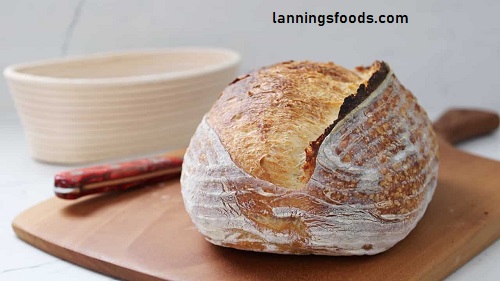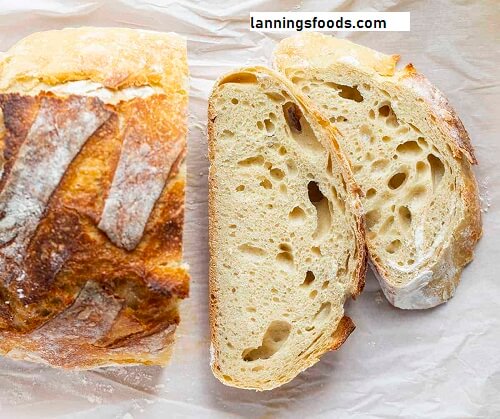Sourdough Quick Bread Recipes:
This One-Hour Sourdough Bread just takes an hour to prepare from beginning to end. Yeast is needed for the single-rise version of this recipe, but the sourdough starter (or discard) adds a lovely flavor and boost of nutrients. If you desire the flavor of sourdough slices of bread but don’t have the time to make a typical loaf, this bread is ideal!

pieces of one-hour sourdough bread on a cutting board covered in black cheesecloth,I had been eager to try out a very quick, very easy sourdough bread because I love baking with sourdough and I love getting things done quickly. I want to share it with you today.
Reasons to adore this sourdough bread:
The rising time is short, and not much kneading is needed. The bread has a smooth, fluffy texture and a soft, somewhat crispy exterior. It cuts easily. It tastes fantastic. Here, there is no compromising of flavor. Most breads need two rise times to develop their flavor and structure entirely, so when you’re in a rush, make sure you’re making up for both rise times.
To hasten the production of gluten, which aids in forming the structure of the bread, I use yeast and bread flour. And I flavor it with the sourdough. The sourdough also gives the bread some oven spring.
It’s easy. However, there is a catch to baking bread: there will likely be a learning curve if you have never cooked bread before.
But if you know how to use a bench scraper, you should have no trouble making this easy sourdough loaf.It’s real bread. It may seem a bit of a gimmick to make bread in an hour, but this is a real, yeast-leavened bread loaf that tastes amazing.
Ingredients:
- Starter for sourdough or throw it out. If you have a strong starter that you recently fed, it would also work well.
- This is a terrific use for sourdough that you were going to dump.
- Bread flour: this gives the bread a better, stronger structure.
- Vegetable oil: Olive oil works well as well, although I personally use avocado oil.
- Any nondairy milk, including oat milk: Milk keeps the crust softer. To achieve a really crispy crust, replace this with an equivalent amount of warm water.
- If you require assistance bringing the dough together, use lukewarm water.
- Sugar: Sugar feeds the yeast and promotes rapid yeast growth while also enhancing the flavor of this quick-rise bread.
- Dry active yeast or instant yeast. Instant yeast yields faster results, but active dried yeast also functions well in this recipe.
- Add salt to your bread for extra taste.

How to bake bread using sourdough:
- Sourdough bread dough on a wooden board for one hour. Till the dough is soft but not sticky, knead it.
- Place a ball of bread dough in a parchment paper-lined bowl.Transfer the dough onto a parchment paper-lined sheet and slide it into a Dutch oven.
- risen bread dough in a parchment paper-lined bowl.After 20 to 25 minutes, or until almost doubled, let the dough rise.
- Before baking, cut a slit in the center of the ball of bread dough.Score the top of the loaf, being careful not to let it collapse, and bake.
- Put all the ingredients (flour, sugar, salt, sourdough scraps, vegetable oil, and nondairy milk) in a bowl. Water is the only item you should not add to the bowl at this time.
- Stir everything together until a dough starts to come together. To help the yeast wake up faster, make sure the milk is lukewarm when you add it.
- Now gradually add the water to create a soft, but not sticky, pliable dough; you may not need to use all of the water.
- When the dough is ready, put it on a piece of parchment paper, lift the paper, and put the parchment paper inside a small Dutch oven.
- Since this is not a large loaf, a smaller pot will result in a boule that is more rounded and better shaped. A flatter loaf can be made with a broader Dutch oven.
- Put the Dutch oven’s lid on and let it sit in a warm area for twenty to twenty-five minutes. Since you want to rise quickly, it’s critical that you locate a warm, comfortable area.
- While the dough is rising, preheat the oven to 500 degrees Fahrenheit.
- The dough should have almost doubled after 20 minutes. Be careful not to deflate the dough as you quickly score the top of it with a sharp or serrated knife or blade.
- After 30 minutes, or when the top of the bread sounds hollow when you tap it with your knuckles, place the Dutch oven, uncovered, in the oven.
- After putting the Dutch oven on a rack for ten minutes, take the parchment paper off of the bread and let it cool further on the rack. Cut into pieces and present.
Guidelines:
Mix all ingredients except water in a large basin or the bowl of a stand mixer that has been fitted with a dough hook.Work the dough into a cohesive ball. Continue kneading for several minutes, gradually incorporating water as required. The dough should be pliable but not sticky.
After the dough has pliable into a ball, transfer it onto a parchment paper-lined sheet and place the sheet inside a Dutch oven. Put the cover on top and store it somewhere warm. It is important to make sure the dough has a compact, cozy, and warm place to rise because you want to do this as quickly as possible and dough takes longer to rise in a slow oven.
While the dough is rising, preheat the oven to 450 degrees Fahrenheit.

The dough should have approximately doubled after 20 to 25 minutes. Now, using a sharp knife or serrated knife, cut a gash on the top of the bread. Put the bread in the preheated oven and bake it for half an hour without a cover.
Take out of the oven. You should hear a hollow sound when you tap your knuckles on the bread. After allowing it to cool in the Dutch oven on a rack for at least ten minutes, take it out and let it cool further on the rack.